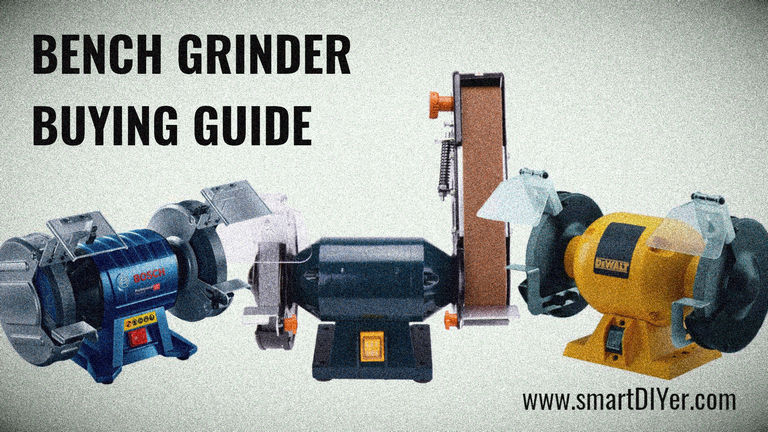Among DIYers, Bench Grinders are not the tools that are used very often. But they do have their own place when it comes to machine tools. A Bench Grinder can be used as a multipurpose power tool for Grinding Tools, Polishing, Buffing, etc. The motor used is an AC Induction motor that requires no maintenance unlike other power tools like Angle grinders, Hand Drills, etc. They are available in both Single Phase and Three Phase connections.
A 3 Phase motor produces more torque and power for the same weight and size compared to a Single-Phase motor. Also, 3 Phase motors are very efficient. For home users, Single Phase motors are the only way to go unless you have an industrial license for 3 Phase connection. Also, the Voltage on which it operates is to be considered. By the way, you can still use 3 phase motors on a single-phase supply using a Phase Converter or a VFD circuit. The decision is yours. VFDs are expensive though.
Pro-Tip: If you want to buy a Grinder for rare use, I suggest buying a 5 or 6” Straight Grinder. You can use the Straight Grinder as Bench Grinder by mounting it to your Bench Vice. This saves a lot of money.
Table of Contents
Here is what you need to look for before buying Bench Grinders.
Bench Grinder Specifications
Size
It’s not how huge it is. What matters is the disc size it will support. Sizes start from 4 inches, 6 inches and 8 inches. 4 inch Bench Grinder has the very least importance in the industry. So I have skipped them.
Smaller size Bench Grinder runs at higher speeds. Whereas larger wheels do not support higher speeds. Just make sure about the RPM limits when using larger discs on smaller grinders.
Power Rating
The least minimum power rating is 150 watts. This is too low for a bench grinder. If your job is only to grind Drill Bits, Chisels, and Milling Tools, this wattage might be sufficient. But when using the bench grinder for stropping knives, blades, etc, then this wattage is not sufficient. For stropping, anything above 300 watts is a minimum requirement.
Generally, Power Ratings vary between 150 watts to 600 watts. I recommend buying at least a 350-watt model for general use.
Arbor Size
This is the size of the Spindle shaft that protrudes on both sides of the Bench Grinder. There are 4 sizes, ½” (12.7 mm), ⅝” (15.88 mm), ¾” (19.05 mm), and 1” (25.4 mm). For industrial purposes 1¼” (31.75 mm) and 1½” (38.1 mm).
The majority of 6” grinders have ½” shaft and 8” models have a ⅝” shaft.
This doesn’t mean that the Wheel’s inner diameter should be the same as the spindle size. All types of adapter bush are available to fit all larger discs onto 6” and 8” grinders.
Weight
A Bench Grinder must have a reasonable weight in order to tackle the vibrations the rotating discs produce. Unbalanced wheels create more vibes. Always use good quality wheels with regular dressing. No recommendations here. The point here is, weight is not an enemy, a friend.
Other Features
Some Bench Grinders come along with an expandable shaft on one side which can be used as a Bench Polisher. This saves the cost to those who need to buy a separate Bench Polisher.
Also, there are grinders with belt sander attachment on one side and a grinding wheel at another end. These would suit the best for Knifemaking purposes. So, buy according to your needs.
Bench Grinder Safety

A Grinding wheel must never be used without safety housing. There are chances of Wheel Shatter by some means of accidents or exceeding RPMs. Some Grinders have spark shields where the operator will be able to see exactly what is grinding. This spark glass also keeps sparks away.
There are some specific angles to grind any tool. Grinding in the wrong way will lead to accidents. The grinder may pull the tool and operator’s hand into itself. Remember not to wear loose clothes and gloves while operating any power tools like Lathe, Milling, Drilling, Angle Grinders, etc. When sharpening Knives and Sickles, always work in a position, such that, even if the disc catches the knife, make sure it doesn’t kick back at you.
Never use larger discs on Small Grinders without reducing RPM. The only way you can control the speed of an Induction Motor is by using a VFD (Variable Frequency Drive).
Wheel Types For Bench Grinder
Silicon Carbide Stone (Mostly Black)
Aluminum Oxide Wheel
Ceramic Wheels
Steel/ Brass Wire Wheel
Flap Wheel
Diamond Wheel
Polishing/ Buffing Wheel
MDF/ Paper Wheel for Knife Sharpening
There are other types of wheels too which are designed specifically to grind one set of tools.
Grinding Wheel Dimensions
Common Grit Sizes are 24, 36, and 60. The above table may be confusing. It all depends on country to country. In some countries, sources are very limited.
| Type | Outer Diameter (mm) | Inner Diameter (mm) | Thickness (mm) |
|---|---|---|---|
| 6” | 150 | 12.7/ 15.88/ 19.05/ 20/ 25.4/ 31.75 | 13/ 16/ 19/ 20/ 25/ 32/ 38/ 40 |
| 8” | 200 | 15.88/ 25.4/ 31.75 | 16/ 19/ 20/ 25/ 32/ 38/ 40 |
Tip: All types of Adapter Bushings are available in the market. And some wheels do come along with Bushings. If not, make some with a lathe. Simple.
Bench Grinder Accessories
Diamond Dressing Tool
Tool Rest
Pedestal Conversion of Bench Grinder
Drill Bit Sharpening Jigs
You may like our Angle Grinder Buying Guide too.
